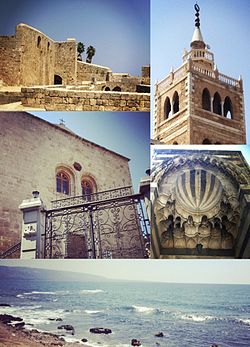Tripoli, Lebanon
|
Tripoli طرابلس Ṭarābulus |
|
|---|---|
| City | |

Clockwise from top left: Citadel of Raymond de Saint-Gilles, Mansouri Great Mosque minaret, Mamluk architecture, bay view, and a Syriac Catholic church
|
|
| Coordinates: 34°26′N 35°51′E / 34.433°N 35.850°ECoordinates: 34°26′N 35°51′E / 34.433°N 35.850°E | |
| Area | |
| • Total | 41 km2 (16 sq mi) |
| Population | |
| • Total | 227,857 |
| Time zone | +2 |
| • Summer (DST) | +3 (UTC) |
| Area code(s) | 06 |
| Website | tripoli-city.org |
Tripoli (Arabic: طرابلس / ALA-LC: Ṭarābulus;Lebanese Arabic: Ṭrāblos;Turkish: Trablusşam) is the largest city in northern Lebanon and the second-largest city in the country. Situated 85 kilometers (53 miles) north of the capital Beirut, it is the capital of the North Governorate and the Tripoli District. Tripoli overlooks the eastern Mediterranean Sea, and it is the northernmost seaport in Lebanon. It holds a string of four small islands offshore, and they are also the only islands in Lebanon. The Palm Islands were declared a protected area because of their status of haven for endangered loggerhead turtles (Chelona mydas), rare monk seals and migratory birds.
Even though the history of Tripoli dates back at least to the 14th century BCE, the city is famous for having the largest Crusader fortress in Lebanon (the Citadel of Raymond de Saint-Gilles), and it has the second largest amount of Mamluk architectural heritage on earth (behind Cairo).
With the formation of Lebanon and the 1948 breakup of the Syrian-Lebanese customs union, Tripoli, once on par in economic and commercial importance to Beirut, was cut off from its traditional trade relations with the Syrian hinterland and therefore declined in relative prosperity.
Tripoli borders the city of El Mina, the port of the Tripoli District, which it is geographically conjoined with to form the greater Tripoli conurbation.
...
Wikipedia

